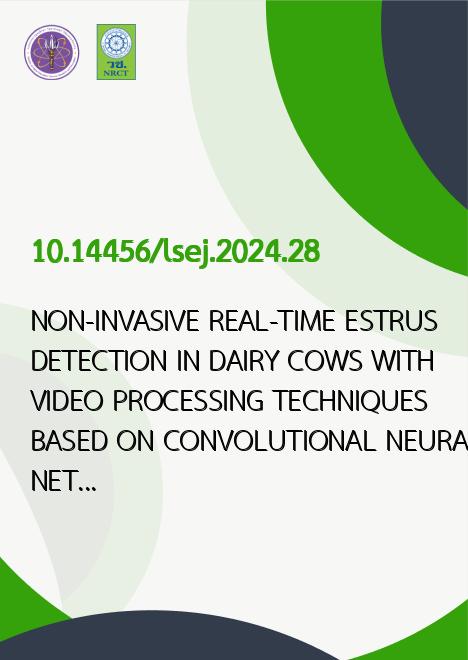
|
NON-INVASIVE REAL-TIME ESTRUS DETECTION IN DAIRY COWS WITH VIDEO PROCESSING TECHNIQUES BASED ON CONVOLUTIONAL NEURAL NETWORKS |
|---|---|
| รหัสดีโอไอ | |
| Creator | Adisak Sangsongfa |
| Title | NON-INVASIVE REAL-TIME ESTRUS DETECTION IN DAIRY COWS WITH VIDEO PROCESSING TECHNIQUES BASED ON CONVOLUTIONAL NEURAL NETWORKS |
| Contributor | Watchara Ninphet, Phayung Meesad, Noppadol Amdee |
| Publisher | Pibulsongkram Rajabhat University |
| Publication Year | 2567 |
| Journal Title | Life Sciences and Environment Journal |
| Journal Vol. | 25 |
| Journal No. | 2 |
| Page no. | 360-379 |
| Keyword | estrus, dairy cows, video processing, convolutional neural networks |
| URL Website | https://ph01.tci-thaijo.org/index.php/psru/index |
| Website title | Life Sciences and Environment Journal |
| ISSN | 2773-9201 |
| Abstract | Estrus detection in dairy cows is a crucial factor in enhancing breeding effi-ciency and achieving sustainable milk production in the dairy farming industry. This research aims to develop an algorithm and evaluate the performance of a real-time estrus detection model for dairy cows without the use of wearable devices. The model utilizes video processing techniques based on evolutionary neural networks. Estrus behaviors in Holstein Friesian cows with at least 75% Holstein bloodline, with a sample size of at least 10 cows, were detected across four behaviors: walking, flirt-ing (sniffing or licking), mating (mounting), and head mounting (playful or incorrect mounting). A total of 1,520 images, with 380 images per behavior, were used. The dataset was augmented using various image augmentation techniques, increasing the dataset size by 22.238 times, resulting in a total of 33,802 images. The estrus detec-tion model was developed using the YOLOv7 evolutionary neural network. The batch size was set at 16, with 30 epochs, and images were resized to 640x640 pixels. The results indicated that YOLOv7 effectively detected estrus behaviors with an average F1-Score of 1.00, Precision of 1.00, Recall of 1.00, [email protected] of 0.996, and [email protected]:.95 of 0.845. These results demonstrate that the model is suitable for prac-tical application in dairy farming, providing an alternative to human labor for estrus detection in cows. |